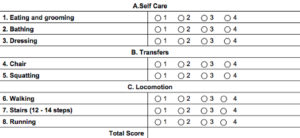Hemophilia treatment has advanced rapidly in recent years. With prophylaxis as the new standard of care starting in early childhood, bleeds are effectively minimized and we turn to joint health as an indicator of treatment success. But with gene therapy around the corner and the entire paradigm of medicine shifting in response to the pandemic, we must rethink our outcomes and how we assess them. How can we advance digital hematology with consideration for the complexities of joint health?
First, let’s look into the current standard for scoring joint health. The Hemophilia Joint Health Score (HJHS) was created in 2003 by merging several now-outdated systems. The HJHS rates the impact of recurrent bleeding on the major joints across 11 symptoms including swelling, strength, and pain. Validated globally and sensitive enough to pick up subtle differences, HJHS quickly became the gold standard for clinical monitoring and comparative outcomes research. Training for how to administer the test involves registration, instructions, worksheets, addendums, and videos — available in 4 languages. The test takes 90 minutes to administer and must be done in person.
Other systems have arisen incorporating ultrasound imaging for even earlier detection of joint damage. The HEAD-US and JADE systems allow hematologists and physical therapists to interpret ultrasound images in great detail without the need for a radiologist. Some clinicians use MRI and x-ray imaging, and still others use the original WFH scoring system pioneered in the early 1980s.
Indeed, a wide range of systems have arisen to help clinicians zero in on joint health, but are they scalable in a globalized and digital world? On the clinician side, these systems require training, which is not available in all languages. Some require special equipment or furniture, and all must be done in-person. And how does this approach engage the patient? As patient-centered care gains traction, we are seeing that patients want outcomes that encompass the entire cycle of care, from survival to functional status and quality of life.
Enter the FISH system, introduced in 2007. This system evaluates functional independence in layman’s terms, making it very easy to understand for patients and clinicians alike. To create the system, hemophilia patients, therapists, and caregivers were asked to identify activities of daily living that are affected by hemophilia. Eight activities were chosen, and each activity is graded according to the amount of assistance required to perform it.
Functional Independence Score in Hemophilia (FISH) scoring sheet
Though FISH is intended to complement other joint score systems, it is the only test that can be performed remotely with little to no training or equipment. Plus, it is easily understood across languages. Although it is less clinically rigorous, the accessibility of FISH gives the potential to outpace other systems. With telemedicine gaining popularity and home testing kits becoming more accessible, it is not hard to imagine a world where hemophilia can be largely treated remotely.
Imagine: You meet with your doctor via video chat. They analyze your blood from a mail-in test. Together, you assess your joint health based on your daily activities. Medication is delivered to your door. Doesn’t that sound easy? With the world growing increasingly digital, it is up to the healthcare industry to sync with the times; putting tools directly in the hands of the patient and making healthcare accessible to all.
From the blog
Posted October 23, 2023
MicroHealth Talk at 2023 Sickle Cell in Focus Conference
Our team was excited to share about the pilot SCD Warrior app and our ongoing collaboration with the National Institutes of Health!...Read more.
Posted April 20, 2021
Top 5 Benefits of App-Based Remote Monitoring for Bleeding Disorders
...Read more.
Posted January 11, 2021
Announcing the Vial Combinator Tool for Pharmacists
Today we proudly announce the launch of our Vial Combinator, a tool to help pharmacists streamline the prescription filling process....Read more.

